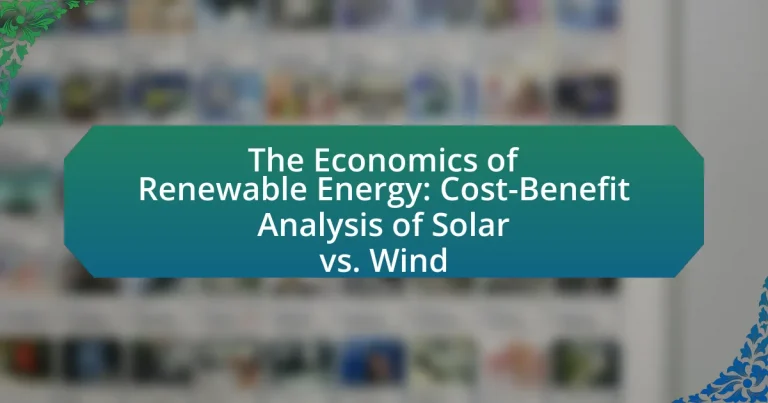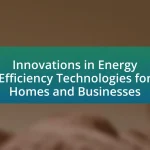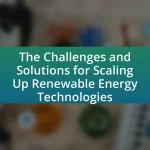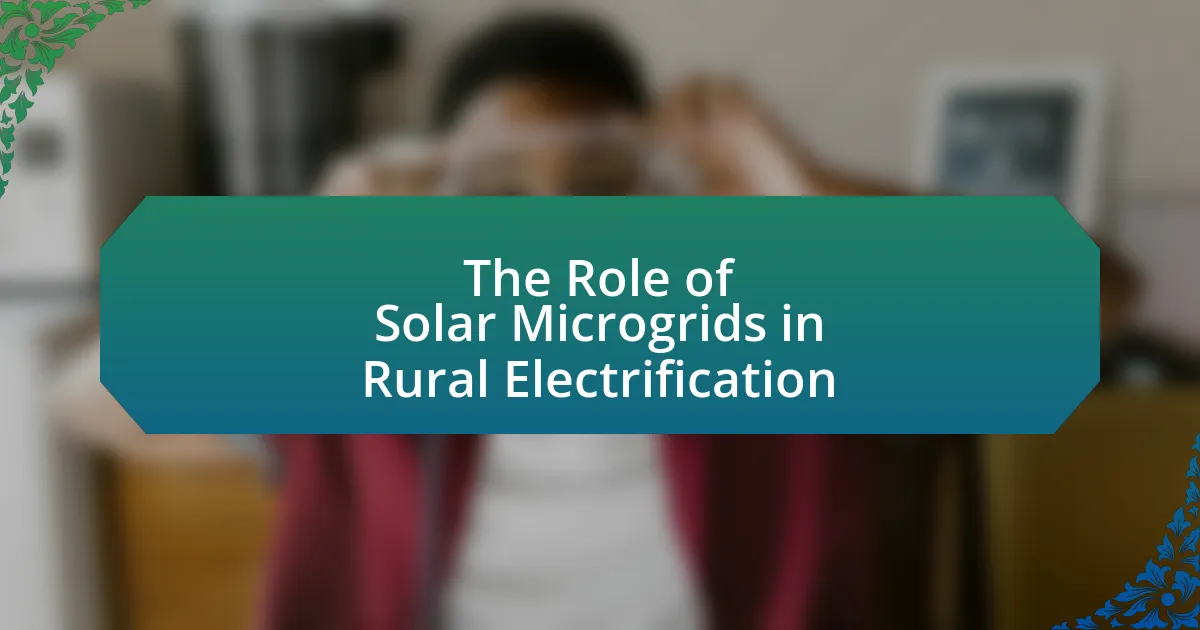The main entity of the article is the economics of renewable energy, specifically focusing on the cost-benefit analysis of solar and wind energy. The article examines the financial implications of investing in renewable energy sources, highlighting significant cost reductions in solar and wind technologies, which have made them increasingly competitive with fossil fuels. It discusses the impact of renewable energy on economic growth through job creation and technological innovation, key economic indicators such as levelized cost of energy (LCOE), and the comparative advantages of renewable investments over fossil fuels. Additionally, the article addresses the importance of cost-benefit analysis in decision-making, the challenges faced by the renewable energy sector, and best practices for stakeholders to maximize the benefits of solar and wind initiatives.
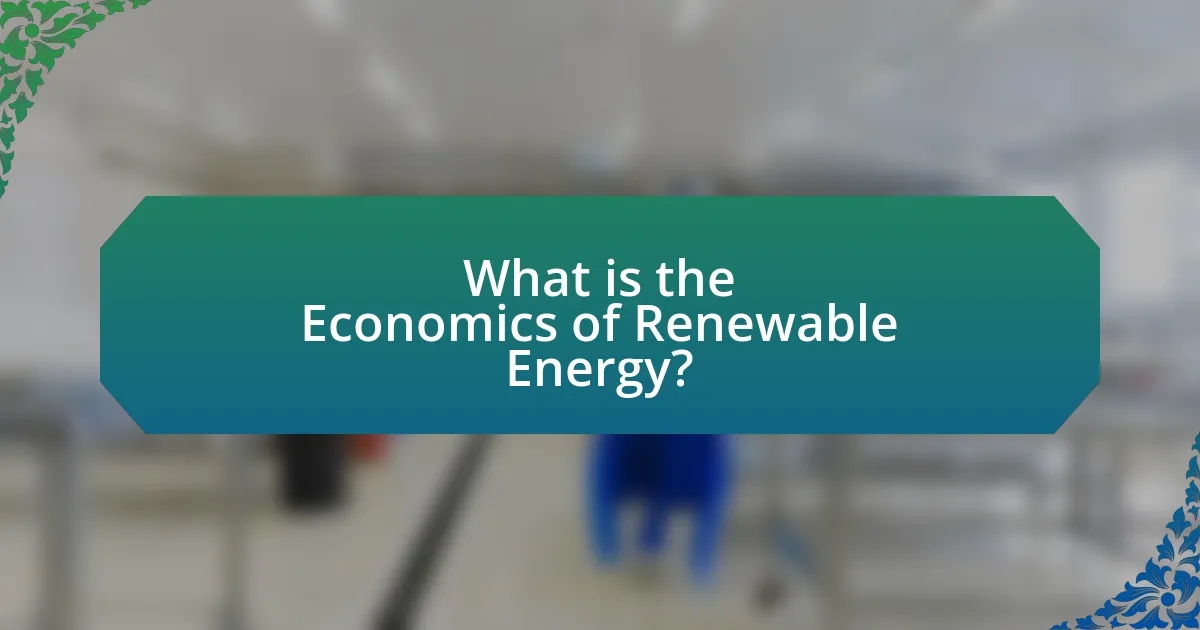
What is the Economics of Renewable Energy?
The economics of renewable energy refers to the financial aspects and implications of investing in and utilizing renewable energy sources, such as solar and wind power. This field analyzes costs, benefits, and market dynamics associated with renewable energy technologies. For instance, the levelized cost of electricity (LCOE) for solar has decreased by approximately 89% since 2009, making it increasingly competitive with fossil fuels. In contrast, wind energy has also seen significant cost reductions, with onshore wind LCOE dropping by about 70% in the same period. These trends indicate that renewable energy is becoming more economically viable, leading to increased adoption and investment in these technologies.
How do renewable energy sources impact economic growth?
Renewable energy sources significantly enhance economic growth by creating jobs, reducing energy costs, and fostering technological innovation. For instance, the International Renewable Energy Agency reported that the renewable energy sector employed over 11 million people globally in 2018, with projections indicating continued job growth as investments in these technologies increase. Additionally, renewable energy can lower energy prices; a study by Lazard in 2020 found that the levelized cost of energy for solar and wind has decreased by 88% and 69%, respectively, since 2009, making them more competitive with fossil fuels. Furthermore, investment in renewable technologies drives innovation, leading to advancements that can stimulate further economic activity. Thus, the integration of renewable energy sources into the economy not only supports job creation but also contributes to lower energy costs and technological progress, all of which are vital for sustained economic growth.
What are the key economic indicators for renewable energy?
The key economic indicators for renewable energy include the levelized cost of energy (LCOE), capacity factor, and investment trends. The LCOE measures the average cost to produce electricity over the lifetime of a renewable energy project, providing a direct comparison between different energy sources; for instance, as of 2023, the LCOE for solar has dropped to around $30 per megawatt-hour, while wind averages about $40 per megawatt-hour. The capacity factor indicates the efficiency of energy production, with solar typically ranging from 15% to 25% and wind from 30% to 50%, reflecting the reliability of these sources. Investment trends, such as global investments in renewable energy reaching $500 billion in 2022, highlight the growing economic commitment to these technologies. These indicators collectively inform stakeholders about the viability and competitiveness of renewable energy in the market.
How do renewable energy investments compare to fossil fuels?
Renewable energy investments generally offer higher long-term returns and lower operational costs compared to fossil fuels. According to the International Renewable Energy Agency (IRENA), the cost of solar photovoltaic (PV) and onshore wind energy has decreased by 82% and 49% respectively since 2010, making them increasingly competitive with fossil fuels. In contrast, fossil fuel investments are subject to volatile market prices and regulatory risks, which can lead to unpredictable returns. Additionally, renewable energy sources contribute to reduced greenhouse gas emissions, aligning with global sustainability goals, while fossil fuels continue to be a major source of pollution.
Why is a cost-benefit analysis important in renewable energy?
A cost-benefit analysis is important in renewable energy because it quantifies the economic viability of projects, allowing stakeholders to make informed decisions. This analysis evaluates the total expected costs against the total expected benefits, providing a clear framework for comparing different energy sources, such as solar and wind. For instance, a study by the National Renewable Energy Laboratory found that the levelized cost of electricity from solar has decreased by 89% since 2009, making it a competitive option when compared to traditional energy sources. By systematically assessing these factors, a cost-benefit analysis helps identify the most efficient and sustainable energy solutions, ensuring optimal allocation of resources in the transition to renewable energy.
What factors are considered in a cost-benefit analysis?
A cost-benefit analysis considers several key factors, including direct costs, indirect costs, benefits, and time value of money. Direct costs encompass expenses such as installation, maintenance, and operational costs associated with renewable energy projects like solar and wind. Indirect costs may include environmental impacts and social costs. Benefits are quantified in terms of energy savings, reduced emissions, and potential job creation. The time value of money accounts for the present value of future cash flows, ensuring that benefits and costs are evaluated over the project’s lifespan. These factors collectively provide a comprehensive assessment of the economic viability of renewable energy options.
How does a cost-benefit analysis influence policy decisions?
A cost-benefit analysis influences policy decisions by providing a systematic approach to evaluate the economic feasibility of different options. This analytical tool quantifies the expected costs and benefits associated with renewable energy projects, such as solar and wind, enabling policymakers to compare alternatives effectively. For instance, a study by the National Renewable Energy Laboratory found that the benefits of solar energy projects often outweigh their costs, leading to increased investment and favorable policy frameworks. By presenting clear data on potential returns and expenditures, cost-benefit analyses guide decision-makers in prioritizing projects that maximize economic and environmental benefits.

What are the main differences between solar and wind energy?
Solar energy harnesses sunlight through photovoltaic cells or solar thermal systems, while wind energy captures kinetic energy from wind using turbines. The primary difference lies in their energy sources: solar energy is dependent on sunlight availability, which can be intermittent and varies by location and time of day, whereas wind energy relies on wind patterns, which can also be inconsistent but are often more predictable in certain regions. Additionally, solar installations typically require more land per unit of energy produced compared to wind farms, which can generate more energy in less space. According to the U.S. Department of Energy, the levelized cost of energy for solar has decreased by 89% since 2009, while wind energy costs have dropped by 70% in the same period, indicating that both technologies are becoming increasingly cost-effective but have different economic implications based on their operational characteristics and resource availability.
How do solar and wind energy systems operate?
Solar energy systems operate by converting sunlight into electricity using photovoltaic cells, which generate direct current (DC) electricity when exposed to sunlight. This electricity is then converted to alternating current (AC) by an inverter for use in homes and businesses. Wind energy systems function by harnessing the kinetic energy of wind through turbines, which rotate blades connected to a generator that produces electricity. According to the U.S. Department of Energy, solar energy systems can achieve efficiencies of around 15-20%, while modern wind turbines can convert approximately 35-45% of wind energy into electricity, demonstrating their effectiveness in energy generation.
What are the technological components of solar energy systems?
The technological components of solar energy systems include solar panels, inverters, mounting systems, batteries, and charge controllers. Solar panels, typically made of photovoltaic cells, convert sunlight into electricity. Inverters are essential for converting the direct current (DC) produced by solar panels into alternating current (AC) for use in homes and businesses. Mounting systems secure the solar panels to rooftops or the ground, ensuring optimal positioning for sunlight exposure. Batteries store excess energy generated during the day for use at night or during cloudy periods, while charge controllers regulate the flow of electricity to and from the batteries, preventing overcharging and damage. These components work together to create an efficient solar energy system, contributing to the overall effectiveness and reliability of solar power as a renewable energy source.
What are the technological components of wind energy systems?
The technological components of wind energy systems include wind turbines, which consist of rotor blades, a nacelle, a tower, and a foundation. Wind turbines convert kinetic energy from wind into mechanical energy, which is then transformed into electrical energy through a generator housed within the nacelle. The rotor blades capture wind energy, while the tower elevates the turbine to access stronger winds. The foundation secures the turbine to the ground, ensuring stability. According to the U.S. Department of Energy, as of 2021, the average capacity of onshore wind turbines has increased significantly, with modern turbines typically exceeding 2.5 megawatts, demonstrating advancements in technology and efficiency in wind energy systems.
What are the economic costs associated with solar and wind energy?
The economic costs associated with solar and wind energy primarily include initial capital investment, maintenance expenses, and integration into existing energy systems. For solar energy, the average installation cost ranges from $2,500 to $3,500 per installed kilowatt, while wind energy costs approximately $1,200 to $1,700 per installed kilowatt. Additionally, solar panels typically have a lifespan of 25-30 years, requiring periodic maintenance that can cost around $20 to $30 per panel annually. Wind turbines also incur maintenance costs, averaging about $42,000 per year for a 2 MW turbine. Furthermore, both energy sources face costs related to grid integration, which can be significant due to the need for energy storage solutions and infrastructure upgrades to accommodate variable energy generation. These figures illustrate the financial implications of adopting solar and wind energy technologies.
How do installation and maintenance costs differ between solar and wind?
Installation costs for solar energy systems are generally lower than those for wind energy systems. For solar, the average installation cost ranges from $2,500 to $3,500 per installed kilowatt, while wind installations can cost between $3,000 and $6,000 per installed kilowatt. Maintenance costs also differ; solar systems typically incur lower annual maintenance costs, averaging about $20 to $30 per installed kilowatt, compared to wind systems, which can average $100 to $200 per installed kilowatt due to the mechanical components involved. These figures illustrate that solar energy systems tend to be more cost-effective in both installation and maintenance compared to wind energy systems.
What are the long-term financial implications of solar vs. wind energy?
The long-term financial implications of solar energy compared to wind energy indicate that solar energy generally has lower operational costs and higher return on investment over time. Solar energy systems typically require less maintenance and have longer lifespans, with average costs dropping to around $0.05 per kilowatt-hour (kWh) in recent years, while wind energy costs average about $0.01 to $0.02 per kWh. However, wind energy often benefits from higher capacity factors, meaning it can produce more energy relative to its size, which can lead to greater overall revenue generation.
According to the International Renewable Energy Agency (IRENA), the levelized cost of electricity (LCOE) for solar has decreased by 89% since 2009, while wind energy costs have fallen by 70% in the same period. This trend suggests that solar energy may become increasingly competitive, especially in regions with high sunlight exposure. Additionally, the initial capital investment for solar installations can be lower than that for wind farms, which often require significant land and infrastructure.
In summary, while both solar and wind energy present viable long-term financial benefits, solar energy tends to offer lower operational costs and a more straightforward installation process, whereas wind energy can leverage higher energy output potential.
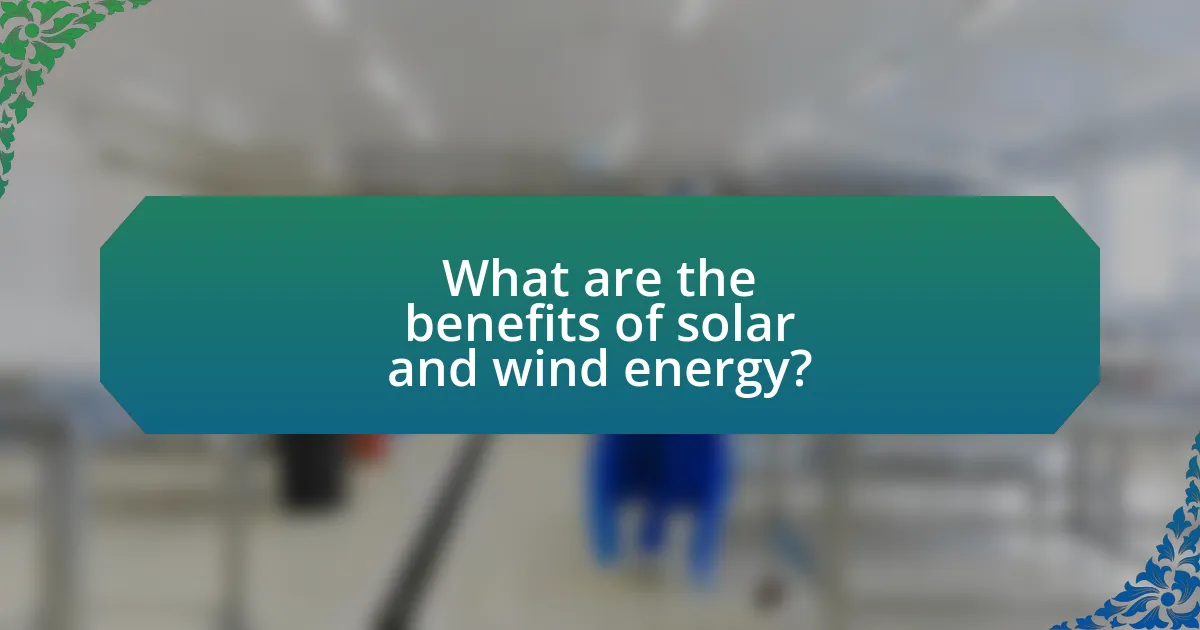
What are the benefits of solar and wind energy?
Solar and wind energy provide significant benefits, including reduced greenhouse gas emissions and lower energy costs. Solar energy systems can decrease electricity bills by generating power on-site, while wind energy can offer competitive pricing due to low operational costs. According to the International Renewable Energy Agency (IRENA), the cost of solar photovoltaic (PV) electricity has dropped by 89% since 2009, making it one of the most affordable energy sources globally. Additionally, both solar and wind energy contribute to energy independence by reducing reliance on fossil fuels, enhancing energy security. The U.S. Department of Energy reports that wind energy alone has the potential to supply 20% of the nation’s electricity by 2030, further illustrating its viability as a sustainable energy source.
How do solar and wind energy contribute to environmental sustainability?
Solar and wind energy contribute to environmental sustainability by significantly reducing greenhouse gas emissions and reliance on fossil fuels. Solar energy harnesses sunlight to generate electricity without emitting carbon dioxide, while wind energy captures wind currents to produce power, also with minimal emissions. According to the U.S. Energy Information Administration, in 2020, renewable energy sources, including solar and wind, accounted for about 20% of electricity generation in the United States, leading to a reduction of approximately 1.7 billion metric tons of carbon dioxide emissions compared to fossil fuel sources. This transition not only mitigates climate change but also promotes cleaner air and water, enhancing overall ecosystem health.
What are the carbon footprint reductions associated with solar and wind?
Solar and wind energy significantly reduce carbon footprints by displacing fossil fuel emissions. Specifically, solar energy can reduce carbon emissions by approximately 90% compared to traditional coal power, while wind energy can achieve a reduction of about 80% compared to natural gas. According to the U.S. Department of Energy, the deployment of solar and wind technologies has led to a decrease of over 200 million metric tons of carbon dioxide emissions annually in the United States alone. This substantial reduction underscores the effectiveness of these renewable energy sources in combating climate change and promoting environmental sustainability.
How do solar and wind energy impact local economies?
Solar and wind energy positively impact local economies by creating jobs, increasing tax revenues, and stimulating local businesses. The installation and maintenance of solar panels and wind turbines generate employment opportunities; for instance, the U.S. solar industry employed over 250,000 workers in 2020, according to the Solar Foundation’s National Solar Jobs Census. Additionally, renewable energy projects contribute to local tax bases, providing funding for schools, infrastructure, and public services. A study by the National Renewable Energy Laboratory found that wind energy projects can increase local tax revenues by millions of dollars over their operational lifetimes. Furthermore, local businesses benefit from increased economic activity as renewable energy projects often require local services and materials, thereby enhancing community growth and sustainability.
What are the challenges faced by solar and wind energy sectors?
The solar and wind energy sectors face significant challenges including intermittency, high initial capital costs, and infrastructure limitations. Intermittency refers to the variable nature of solar and wind resources, which can lead to reliability issues in energy supply; for instance, solar energy generation is dependent on sunlight availability, while wind energy relies on wind speed, both of which can fluctuate. High initial capital costs are a barrier to entry, as the installation of solar panels and wind turbines requires substantial investment; according to the International Renewable Energy Agency, the average cost of solar photovoltaic systems was around $1,000 per kilowatt in 2020. Infrastructure limitations, such as inadequate grid capacity and transmission lines, hinder the effective distribution of generated energy, particularly in remote areas where renewable resources are abundant. These challenges collectively impact the scalability and economic viability of solar and wind energy projects.
What regulatory hurdles affect solar and wind energy adoption?
Regulatory hurdles affecting solar and wind energy adoption include complex permitting processes, inconsistent policies, and interconnection challenges. Complex permitting processes can delay project timelines, as developers must navigate various local, state, and federal regulations, which can vary significantly across jurisdictions. Inconsistent policies, such as changes in tax incentives or renewable energy standards, create uncertainty for investors and developers, impacting financial viability. Additionally, interconnection challenges arise when integrating renewable energy sources into existing power grids, often requiring extensive upgrades and coordination with utility companies. These factors collectively hinder the growth and implementation of solar and wind energy projects.
How do market fluctuations impact the viability of solar and wind projects?
Market fluctuations significantly impact the viability of solar and wind projects by influencing investment costs, financing conditions, and energy prices. For instance, when commodity prices for materials like silicon or steel rise, the capital costs for solar panels and wind turbines increase, potentially delaying project development or reducing profitability. Additionally, fluctuations in energy prices can affect revenue projections; if market prices for electricity drop, the expected return on investment for renewable projects diminishes, making them less attractive to investors. According to the International Renewable Energy Agency, the cost of solar photovoltaic systems has decreased by 82% since 2010, but this trend can be reversed by sudden market shifts, highlighting the sensitivity of these projects to economic conditions.
How can stakeholders maximize the benefits of solar and wind energy?
Stakeholders can maximize the benefits of solar and wind energy by investing in advanced technologies and optimizing energy storage solutions. By adopting innovative technologies such as smart grids and energy management systems, stakeholders can enhance the efficiency of energy production and distribution. For instance, the International Renewable Energy Agency reported that integrating energy storage can reduce costs and improve reliability, making renewable energy sources more competitive with fossil fuels. Additionally, stakeholders should engage in policy advocacy to promote favorable regulations and incentives that support renewable energy development, as evidenced by the success of feed-in tariffs in countries like Germany, which significantly boosted solar energy adoption.
What best practices should investors follow in renewable energy projects?
Investors in renewable energy projects should conduct thorough due diligence to assess the financial viability and risks associated with solar and wind investments. This involves analyzing market trends, regulatory frameworks, and technological advancements that impact project feasibility. For instance, a report by the International Renewable Energy Agency (IRENA) indicates that understanding local energy policies can significantly influence project success, as supportive regulations can enhance profitability. Additionally, investors should diversify their portfolios across different renewable technologies to mitigate risks, as evidenced by studies showing that diversified investments can lead to more stable returns. Engaging with experienced project developers and leveraging expert insights can further enhance decision-making, ensuring that investments align with best practices in the rapidly evolving renewable energy sector.
How can communities effectively implement solar and wind initiatives?
Communities can effectively implement solar and wind initiatives by conducting comprehensive feasibility studies to assess local resources, infrastructure, and community needs. These studies help identify optimal locations for solar panels and wind turbines, ensuring that projects are economically viable and environmentally sustainable. For instance, a report by the National Renewable Energy Laboratory indicates that communities with strong wind resources can achieve lower energy costs through wind energy deployment, while solar initiatives can significantly reduce electricity bills for residents. Additionally, engaging local stakeholders through workshops and informational sessions fosters community support and participation, which is crucial for successful project implementation.
